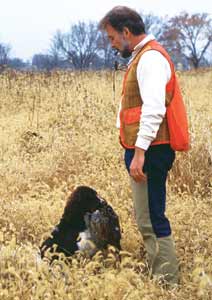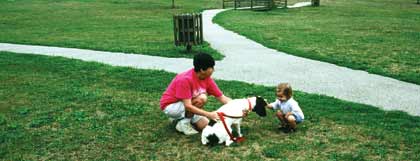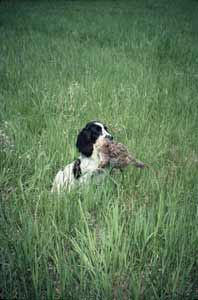It's important to keep "corrections" in perspective.
By John McGonigle
 Consistency and moderation in your training efforts will ultimately produce the desired results. |
Gun dog owners and trainers can learn a lot from trainers of breeds other than our own. When visiting in-laws I spent a lot of time training with a fantastic amateur trainer in North Carolina.
One afternoon we were discussing gun dogs prior to hosing the runs down after feeding his English setters.
"I punish my dogs the same way I punished my children when they were growing up," said Bob Lee, "only as much as necessary to get the job done."
Bird dog enthusiasts from the Carolinas will recognize Lee's name. Under his Pine Cone kennel name he was for years one of the top amateur pointing dog trainers and handlers in quail trials for walking gun dogs. Lee hunted his dogs seriously, especially earlier in his career. What Bob Lee does not know about sporting dogs is unnecessary to know.
I found Lee's statement on punishing dogs interesting, and much at odds with many trainers of his age and time in the sporting dog world; Lee is now in his mid-80s, and has slowed training considerably. But into his 70s, Lee walked three, one-hour championship trial heats in a day, running two of his own dogs and one belonging to an injured friend.
I watched and helped (in very small ways--planting birds, gunning, etc.) Bob Lee train dogs for about 15 years, and his actions regarding punishing or "correcting" dogs was just as he said--minimal. Instead of heavy-handed corrections, Lee relied on patience, consistency, repetition and plenty of bird contact.
Watching him helped me moderate the number and intensity of my corrections.
Coming from a background of competitive football and wrestling at a time when Vince Lombardi's training philosophy ruled sports, I tended to accept and use Lombardi's hard-nosed philosophy in dog training--for a while.
Trained by myself (I followed a book), my first two English springers did pretty well, though they were certainly not flawless. Corrections at the time were moderate, with a lot of exposure to wild birds doing much of the work.
Later I became actively involved with dog trainers in the Valley Forge Field Trial Association. That association became a main focus of my life, and taught me what I know about dogs. It put me in touch with people who knew dogs as well as anyone in the country, and opportunities denied the average hunter.
A couple of old-timers, and some younger members, too, were pretty tough on their dogs and demanded, if not perfection, something pretty darn close to it. In fairness to them, they were competing in the big leagues where perfection, or near perfection, was necessary to win.
The rigid, physical aspect of training correlated with my personal background, so anyone passing those harsh dog training methods on to me was working with pretty fertile, receptive soil.
Some old-time professional dog trainers (some of whom are still living) used some pretty harsh correction methods, including slingshots; air/BB guns; flushing whips; a short, heavy lead; bird shot from a shotgun or hand-gun; misused/abused electronic collars, a booted foot, a fist and a dog being picked up and thrown on its back.
Pros often had dogs they trained and ran removed from their kennels if they were not winning field trials. The pros, in turn, did everything within their power — including some pretty harsh training methods — to ensure dogs remained with the pro. As late as the mid- to late 1990s I still saw some of the same harsh correction methods described above being used.
 A well socialized dog is much less likely to develop behavior problems. |
I now, and for some years previously, use only one method of correction that could be considered harsh. I will occasionally give my dog(s) one sharp lick across the hind end with a short, heavy leather lead, when he knowingly disobeys. Pup feels some pain, and I know it. I also know he understands the reason for the correction€¦if he didn't, I wouldn't use the correction.
My goal is to have full compliance from pup on the first command, and do it repetitively.
If I think pup does not understand, or realize, his transgression, I do not use the lead for a correction.
I would rather give one quick, solid thwack with that lead than nag, nag, nag a dog to comply. I have found that compliance improves, and stays improved, after pup feels the lead. Again, that lead is only used as a correction if pup understands the command or expectation, and ignores or willfully disobeys it.
During early training pup often needs nothing more than a stern "no." Do not get into the habit of hollering "NO"; pup may just learn (actually, it's almost guaranteed) to only respond when he hears "NO" (LOUDLY), rather than "no" (normally).
The harsh correction using the lead noted above is by no means the only correction pup gets as training progresses — and certainly we all know that training never stops.
Once pup is over the very basic training, understands and complies generally, a trainer can use a lead or checkcord on pup's collar to provide a correction. It does not need to be hard for pup to get the message; a quick, short jerk on the lead usually suffices.
Mom trains her pups to a degree before you take one home at seven or eight weeks old. One of her corrections is picking pup up by the scruff of the neck. Trainers can use a similar correction by grabbing pup by the loose skin on each side of his neck and picking him off the ground, while staring directly into his eyes, and giving him a verbal correction.
A little "shake" does not hurt him, but do not overdo it, and do not throw him back to the ground and risk an injury.
Hollering is unnecessary, and counterproductive. Face it; if someone picked you up totally off the ground there is a pretty good chance that he would have your full attention--ditto for pup.
Requiring consistent behavior is a key to obtaining good behavior from pup. Pup will
become confused if one day he is allowed on the couch and the next day he is not.
Another key to obedience and proper behavior is repetition. Dogs are not big thinkers, even though your dog can read you like a book. The fact is, your behavior must be consistent and repetitious to get consistent, proper compliance from your dog.
Corrections must come immediately after the transgression so pup knows what he is being punished for. If a correction cannot be made immediately, avoid it until another opportunity arises.
NEVER call pup to you and then "correct" him when he arrives. He will not come regularly after that. You must go to pup to be effective.
 Using plenty of birds during training will help keep pup's interest level high, thus curtailing many potential problems. |
Spaniel trainers often pick pup up and return him to the point of his infraction. That is valid, but the same thing can be accomplished by quickly snapping a short lead on pup and quickly pulling pup back to where he disobeyed.
The use of a lead spun circularly so pup's head does not get in front of his handler's left leg when learning to heel speeds the process. Additionally, a light switch can also be used in a similar fashion to teach pup his limits. Neither the lead nor the switch should be used heavy-handedly.
Finally, electronic collars can be used for instant corrections, and they are not torture devices. Used properly they help a trainer obtain consistent performance from pup, even when pup is at a distance. Electronic collars help make corrections immediate, thus more effective.
The key to electronic collars is using them judiciously, AFTER pup has learned, and demonstrated that he knows what you want. A collar is not a teaching tool; it is a "reminder" for pup.
Get pup in shape and knock a couple of pounds off of him (yourself, too), do some yard training to sharpen pup's memory and have a safe, successful bird season!






